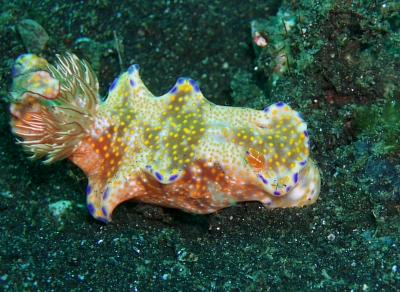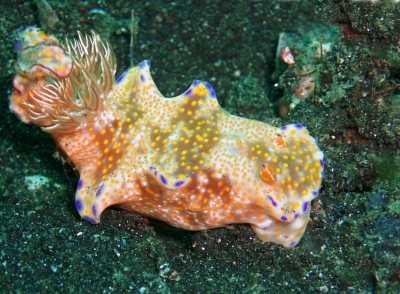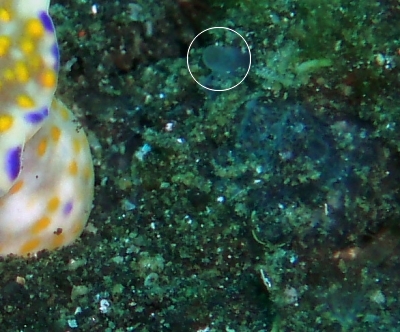Ceratosoma tenue feeding? from Lembeh
July 17, 2007
From: Mike Krampf

I thought you might find these pictures interesting. The Ceratosoma tenue appeared to be feeding, as it was extending and contracting what I assumed to be its mouth. I have no idea what it was eating since as you can see from the pictures it was just crawling across black sand.
Locality: Dive Site - Hairball in Lembeh Strait, 25 ft, North Sulawesi, Indonesia, Molucca Sea, 03 July 2007, Sandy bottom. Length: 8 cm. Photographer: Mike Krampf.
The other thing that I learned from this series of pictures was that the rhinopores can be retracted. As you can see, the first picture shows both while the second only shows one and the third shows the missing rhinopore reapearing.
I'm always amazed at things I notice by looking at pictures on my computer that I didn't notice at the time I was taking the picture.
Cheers,
Mike
mtkrampf@yahoo.com



Dear Mike,
This is another very nice find.
Your message reminds me of a quote I think by Douglas Adams which goes something like "If it looks like a duck and quacks like a duck I think we have to consider the possiblity that we have an aquatic bird of the duck family ..".
Your Ceratosoma is certainly doing exactly what a feeding animal would be doing, so the question to ask is "where is the sponge?" If you look carefully just in front of the animal there are some blue-grey patches which I am sure are parts of a sponge colony partly covered in sand. I have ringed a tube which is one of the siphons for circulating water through the feeding cells of the colony.
This is the first record of Ceratosoma tenue feeding - unfortunately I can't identify the sponge. What it does do though is give us a better perspective on these dark volcanic? sandy bottoms which occur in many parts of Indonesia. In many photos the nudibranchs seem to be crawling over a sterile desert but your photo suggests that at least in some regions the sand may be a very thin layer hiding rich food resources beneath.
If you see a similar event again perhaps it would be worthwhile to try 'fanning' the sand to see if it hiding a sponge beneath. It might even enable you to take a photo we could use to identify the sponge.
Best wishes,
Bill Rudman
Related messages
-
Re: Ceratosoma tenue from Lembeh - with brittle-star
From: Teresa Zuberbühler, June 6, 2008 -
Ceratosoma tenue from Lembeh - feeding?
From: Kamal El Tawil, April 2, 2008 -
Ceratosoma tenue from sthn Queensland
From: Gary Cobb, October 12, 2007 -
Ceratosoma tenue feeding [3]
From: Bruce Wilkie, October 11, 2007 -
Ceratosoma tenue feeding [2]
From: Bruce Wilkie, October 11, 2007 -
Ceratosoma tenue feeding [1]
From: Bruce Wilkie, October 11, 2007 -
Ceratosoma tenue from Anilao, The Philippines
From: Paul Osmond, April 10, 2007 -
Ceratosoma tenue mating
From: Bruce Wilkie, May 31, 2006 -
Ceratosoma tenue with eggs from Buton Island
From: Linda Ianniello, December 1, 2005 -
Ceratosoma tenue laying eggs
From: Mary Jane Adams, October 26, 2005 -
Ceratosoma tenue from Sth Africa
From: Riaan Marx, February 23, 2004 -
Ceratosoma tenue from Sodwana, Sth Africa
From: Charles Rowe, February 5, 2004 -
Ceratosoma tenue with egg ribbon
From: Danny Van Belle, June 5, 2003 -
Ceratosoma tenue from Sth Korea
From: Dong Bum Koh, May 30, 2003 -
A Ceratosoma convention
From: Danny Van Belle, May 28, 2003 -
Ceratasoma tenue from North Sulawesi
From: Marli Wakeling, October 12, 2002 -
Variation: Ceratosoma tenue
From: Valda Fraser, August 12, 2001 -
Ceratosoma tenue from Southern Mozambique
From: Ian Miller, December 19, 2000 -
Mystery slug from Indonesia
From: Marli Wakeling, October 29, 2000 -
Ceratosoma tenue from South Africa
From: Valda Fraser, November 5, 1999 -
Re: Ceratosoma tenue from South Africa
From: Valda Fraser , November 5, 1999
